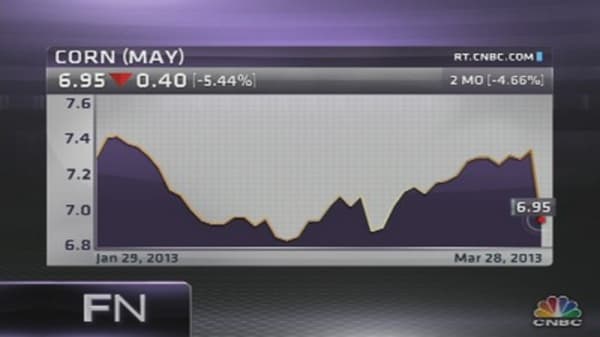It's still a little early to tell what the longer view is, but at least in the near term the outlook for corn is rough.
"We have to look at the upcoming corn crop rather than what's influencing prices Thursday and today," said David Maloni, economist at the American Restaurant Association. The price drop is "a good sign and it makes us more optimistic. It certainly helps."
The ARA has a $4 a bushel price target for corn by year's end—far more bearish than others but part of a trend that sees the commodity's price falling.
(Read More: Restaurants Hope Tax Refunds Bring Customers)
Following up on the last two sessions' price action, Goldman Sachs said Monday it is taking down its three-month forecast from $7.50 a bushel to $6.50.
Though Goldman had expected prices to hold up better in the near term, it is predicting a sharp downturn later in the year.
"Medium term, the combination of decent weather in South America and the potential for a recovery in U.S. production point to sharply lower prices in (the second half of) 2013," Goldman said in a recent note to clients. "However, given the persistence of the U.S. drought, we believe that better U.S. weather will be required for this move to materialize."
Last week's crop report noted nearly 400 million bushels more of corn on hand than anticipated.
At the same time, expectations are for a strong crop in the planting season ahead that also likely will weigh on prices.
"You have to see how that plays out," said Tom Porcelli, chief U.S. economist at RBC Capital Markets. "These futures prices take time before they show through at the consumer level."
Consumers can only hope for some relief from an onslaught of higher prices. Some say the commodities run has been an offshoot from the Federal Reserve's zero-interest-rate policies that have pushed investors and speculators into higher-risk assets like commodities, which have benefited from a weaker dollar.
A look at prices shows how tough things have been at the grocery store.
(Read More: Gulp! Soda Consumption Declines to Lowest Level Since 1996)
Produce has soared over the past year, with grapes and iceberg lettuce rising 37 percent and oranges up more than 17 percent, according to the most recent data from the Bureau of Labor Statistics.
Eggs are up more than 9 percent, leaner cuts of ground beef have surged more than 20 percent and chicken is 7.5 percent higher. And of course, there's gasoline, which has been on a downtrend as of late but is up more than 4 percent from a year ago.
"We've had a fairly good run-up, obviously," said Peter Cardillo, chief market economist at Rockwell Global Capital. "It's really too early to tell whether we're going to see some relief."
—By CNBC's Jeff Cox. Follow him on Twitter@JeffCoxCNBCcom.





